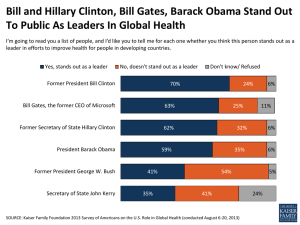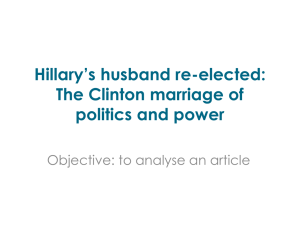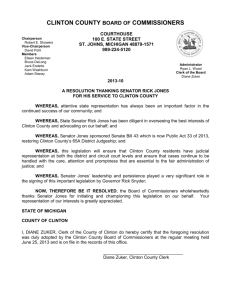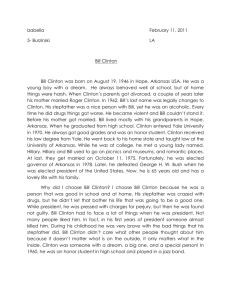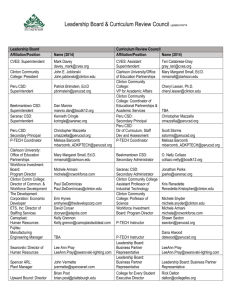The Clinton Administration`s Health Care Reform Proposal
advertisement
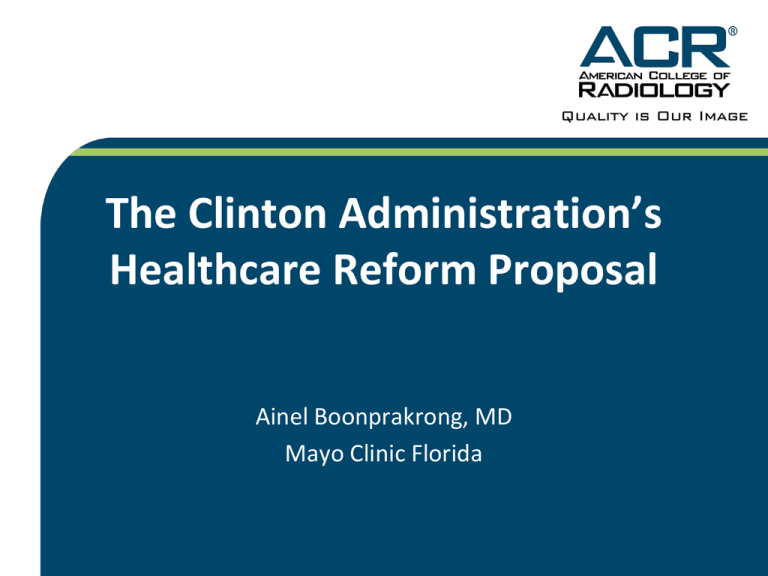
The Clinton Administration’s
Healthcare Reform Proposal
Ainel Boonprakrong, MD
Mayo Clinic Florida
In the Beginning…
• On September 22, 1993, President Clinton appeared
before the American people to discuss his plans to
reform the health care system
• Subsequently, on November 20, 1993, the Health
Security Act ('HSA') was introduced into Congress
– The Health Security Act sets the framework for a national
health care system. It is a complex bill, over 1500 pages
long
The Proposal…
• The Clinton plan sought to build on and transform our mixed, public–
private system of health care
• It called for universal coverage, with all employers required to contribute
toward the costs of insurance premiums for their workers. Americans
would choose from multiple private insurance plans that would compete
for their enrollment, and it was expected that the market would shift
further toward managed care
• Through regional purchasing pools, the government would strictly
regulate insurance practices. It would also impose limits on the growth of
insurance premiums to ensure cost control.
• The Clinton plan was envisioned as a synthesis of liberal ends (universal
coverage) and conservative means (managed competition among private
insurers)
• Other core elements were designed to maximize its political appeal: the
plan built on the familiar system of employer-sponsored insurance,
avoided any new taxes, retained private insurance, left Medicare intact,
and promised Americans health security and choice.
Coverage…
• Under the Clinton healthcare reform, coverage was
extended to:
– citizens or nationals of the United States; an alien permanently
residing in the United States under color of law; or a long- term
nonimmigrant.
• Medicare-eligible individuals entitled to health benefits
under the Medicare program, military personnel and
families, veterans and Indians were to have a choice of
health plan coverage
• Prisoner and undocumented aliens, however, were
ineligible for benefits
Benefits
• The Health Security Act proposed to reform the health care
system so that all Americans are guaranteed comprehensive
health coverage.
• The benefits package consists of:
–
–
–
–
–
–
–
–
–
hospital services
services of health professionals
clinical preventive services, home health care, ambulance services
outpatient laboratory, radiology, and diagnostic services.
outpatient prescription drugs
outpatient rehabilitation services
medical equipment and devices
vision care, dental care,
investigational treatments
First Lady’s Role
• The First Lady's role in the secret proceedings of the Health Care
Task Force sparked litigation in the U.S. Court of Appeals for the
D.C. Circuit, in relation to the Federal Advisory Committee Act
(FACA), which requires openness in government
• The Clinton White House argued that the Recommendation Clause
in Article II of the U.S. Constitution would make it unconstitutional
to apply the procedural requirements of FACA to Hillary's
participation in the meetings of the Task Force
• Ultimately, Hillary Clinton won the litigation when the D.C. Circuit
ruled narrowly that the First Lady of the United States can be
deemed a government official (and not a mere private citizen) for
purposes of not having to comply with the procedural
requirements of FACA
Opposition
• Opposition to the Clinton plan was initiated by William Kristol
and his policy group Project for the Republican Future, which
is widely credited with orchestrating the plan's ultimate
defeat
• A key turning point against the Clinton plan was a televised
town hall meeting in April 1994. During the event, President
Clinton was challenged by businessman Herman Cain on the
effects on small businesses by the enforced mandate for
employers to provide health insurance coverage to all of their
employees
Opposition
• Clinton’s proposal promised benefits for average Americans
with tight, new regulations intended to push employers,
doctors, hospitals, and insurance companies toward cost
cutting
• Interested parties in the health care economy became very
worried about their profits and their freedom to maneuver.
Privileged middle-class Americans who already had some kind
of health coverage began to fear that Clinton's Health
Security plan might make their health care more costly and
cumbersome
Criticism
• Clinton administration's greatest mistake was likely
excessive ambition. The plan attempted
simultaneously to:
– secure universal coverage
– regulate the private insurance market
– change health care financing through an employer
mandate
– control costs to levels enforced by a national health board
– transform the delivery system through managed care
Defeat
•
Support for the bill peaked at its introduction, with 59 percent of the populace in
favor, but support never exceeded 50 percent after February 1994 and fell to 42
percent by June of that year
•
The basis was laid for an electoral upheaval in November 1994, bringing to power
conservatives who wanted to dismantle rather than extend the federal
government's role in the domestic economy and Social Security
•
In August 1994, Democratic Senate Majority Leader George J. Mitchell introduced
a compromise proposal that would have delayed requirements of employers until
2002, and exempted small businesses. A few weeks later, Mitchell announced that
his compromise plan was dead, and that health care reform would have to wait at
least until the next Congress
•
In that 1994 election, the Republican revolution, led by Newt Gingrich, gave the
GOP control of both the House of Representatives and the Senate for the first time
since the 83rd Congress of 1953–1954, ending prospects for a Clinton-sponsored
health care overhaul
Resources
•
•
•
•
•
http://en.wikipedia.org/wiki/Clinton_health_care_plan_of_1993
http://academic.udayton.edu/health/02organ/clinton.htm
http://www.princeton.edu/~starr/20starr.html
http://www.nejm.org/doi/full/10.1056/NEJMp078201
http://articles.cnn.com/2009-0722/politics/obama.clinton.health.care_1_health-care-clintoninitiatives-hillary-clinton?_s=PM:POLITICS
• http://www.rwjf.org/reports/grr/023490.htm
